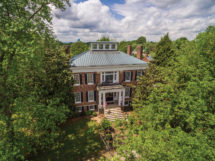
Having finally traversed the mountains into the land that became Kentucky, early settlers wasted no time in establishing gathering places to practice the religious freedom that America promised. Catholics and Protestants alike established roots in central Kentucky, specifically in the area around Bardstown, Springfield and Lebanon. Today on the Kentucky Holy Land Trail, you can absorb early spiritual history, explore religious sites, stay at a retreat center and also discover the surprising connection between the commonwealth’s spiritual side and America’s native spirit, bourbon.
History
In 1775, lured by rich Bluegrass farmland, Catholics began settling in what are now Washington, Marion and Nelson counties, which became known as “Kentucky’s Holy Land.” Twenty years later, Stephen Badin, the first priest to be ordained in America, set up residence at what is today the Sisters of Loretto. Next came Belgian missionary Charles Nerinckx, who oversaw the establishment of an impressive number of churches, followed by the Dominican friars in 1805, and in 1811, French priest Benedict Joseph Flaget.
As “First Bishop of the American West,” Flaget shepherded the Diocese of Bardstown, the first inland diocese in the U.S. This enormous area stretched from the Great Lakes to the Gulf Coast and from the Alleghenies to the Mississippi River. Under the influential leader, numerous religious establishments began: St. Thomas Seminary, the Sisters of Loretto, the Sisters of Charity of Nazareth, St. Joseph Cathedral in Bardstown, St. Joseph College, St. Mary College, the Dominican Sisters and the Good Shepherd Sisters, the Jesuit Fathers, and the Trappist monks of Gethsemani Abbey.
On the Protestant scene, Scotch-Irish pioneers from Virginia settled in Washington and Marion counties and in 1788, organized Springfield Presbyterian Church. An early elder was John Caldwell, who later became the state’s lieutenant governor. An 1836 bell tower remains from an early building; the current church was built in 1888. The oldest Bardstown establishment was Union Church, built in 1812, which has become the city’s First Baptist Church.
Attractions
Two important sites on the Holy Land Trail are in the Bardstown area. Upon his arrival in 1811, Bishop Flaget first built small St. Thomas Parish Church, then set out to erect a cathedral. Built by Catholics and Protestants, St. Joseph Cathedral opened for services in 1816 as the first west of the Alleghenies. When the Episcopal See moved to Louisville, this national historic landmark, known for its fine paintings and altar adornments, became St. Joseph’s Proto-Cathedral. You can visit it today, along with St. Thomas Parish Church and the circa 1795 Bishop Flaget Log House, the founding site of the Sisters of Charity of Nazareth and where Flaget lived for seven years. A museum tells its story.
Religious-art lovers and readers will want to stop at the Bardstown Art Gallery, now in its 44th year, and the Thomas Merton Bookstore, which features books by the well-known monk, poet and writer, as well as other titles that focus on meditation, mysticism and monasticism.
If you’ve been waiting for the bourbon connection, here it is. Part of the St. Joseph Proto-Cathedral complex, Spalding Hall – the first Catholic college in Kentucky – also served as a Civil War hospital, boys’ orphanage and prep school. Currently, the 1826 brick structure is home to the Oscar Getz Museum of Whiskey History, with rare artifacts dating from pre-colonial to post-Prohibition, including a moonshine still. Sharing the building, the Bardstown Historical Museum adds a nice overview of the Bourbon Capital of the World, and the Rickhouse Restaurant boasts more than 100 bourbons on its menu.
Another cache of religious history is at Lebanon’s Marion County Heritage Center, where a lovely hand-pieced quilt tells the story of the Ursuline Sisters in that area. While there, be sure to peek into the Turtleman Museum for a fascinating exhibit about local legend, Ernie Lee Brown Jr., a.k.a. Animal Planet’s Turtleman.
Retreats
Retreat centers are a bonus on the Holy Land Trail, and your religious affiliation doesn’t matter a whit. Located in Nerinx, the Loretto Community is a 788-acre working farm 60 miles from Louisville with two retreat centers for personal and group retreats. One can accommodate up to 27 people, who can bring their own facilitator or reserve one from Loretto; the other is a cluster of seven woodsy cabins for individual retreats. Also on the grounds are a museum where you can learn about the Sisters of Loretto, amazing activists and educators since Nerinckx founded the order in 1812; an art gallery; and a chapel that’s open to the public for Sunday mass.
Nearby is the Abbey of Gethsemani, a working farm and Trappist monastery that has welcomed guests since its inception in 1848. Unstructured silent retreats are arranged by reservation. Day guests and retreatants may attend daily services, hike on miles of trails through the scenic Knobs country, watch a film at the visitor’s center about monastic life, and purchase monk-made cheeses, fruitcake and bourbon-laced fudge.
North of Bardstown, Nazareth Retreat Center personifies the tradition of the Sisters of Charity of Nazareth in offering those seeking “time out” and a holistic approach to spiritual reflection. Here, guests can add alternative body therapies, such as massage and energy work, to their retreat. And there’s a traditional labyrinth. Begun in the Middle Ages, labyrinths initially enabled pilgrims to make symbolic journeys to the Holy Land. Today, walking a labyrinth is believed to have psychological as well as spiritual benefits.
More Info
Whether your religious experience involves spirituality, bourbon or a combo, you can plan it along the Kentucky Holy Land Trail at KyHolyLand.org, where you can download two maps to guide your journey. For additional information, contact the following tourism agencies: Bardstown – Nelson County Tourist and Convention Commission (800) 638-4877, bardstowntourism.com; Springfield Tourism Commission (2701) 402-5965, seespringfieldky.com; or Lebanon Tourist and Convention Commission (270) 692-0021, VisitLebanonKY.com.



















Add Comment